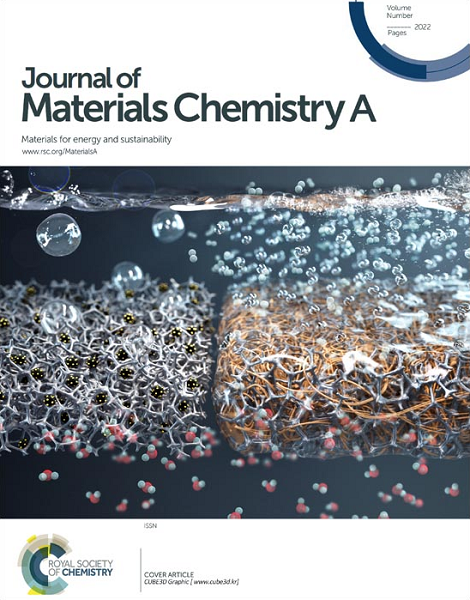零维无机卤化物钙钛矿衍生物Cs₃Cu₂I₅的掺杂和热电性能
IF 9.5
2区 材料科学
Q1 CHEMISTRY, PHYSICAL
引用次数: 0
摘要
卤化物钙钛矿由于具有良好的电荷迁移率和超低的导热性而被认为是一种很有前途的热电材料。由于量子约束效应,低维卤化物钙钛矿衍生物(0D, 1D和2D)被预测具有高热电性能,但这类金属卤化物在实验上尚未得到充分的探索。在这里,我们研究了掺杂钡的全无机0D卤化物钙钛矿Cs3Cu2I5的热电性能。采用固态合成法制备了掺杂钡的球团。在掺杂后,电导率提高了3个数量级,扩展的x射线吸收精细结构测量表明,Ba取代了两个a位中较小的Cs。我们发现热导率处于超低状态,并且随着掺杂而降低,这与缺陷散射的增加相一致。正塞贝克系数为+ 2400±60 μV。Cs3Cu2(1—x)BaxI5 (x = 0.1)的K-1证实了p型掺杂。据我们所知,这是第一次对0D卤化物钙钛矿进行替代掺杂以提高热电性能的研究。本文章由计算机程序翻译,如有差异,请以英文原文为准。
Doping and thermoelectric properties of the zero-dimensional inorganic halide perovskite derivative, Cs₃Cu₂I₅
Halide perovskites have been considered as promising thermoelectric materials due to their unusual combination of good charge mobility and ultralow thermal conductivity. Low dimensional halide perovskite derivatives (0D, 1D and 2D) have been predicted to have high thermoelectric figure of merit due to quantum confinement effects, but this class of metal halides has been under-explored experimentally. Here, we investigate the thermoelectric properties of the all-inorganic 0D halide perovskite, Cs3Cu2I5, doped with barium. Ba-doped pellets were fabricated by solid state synthesis. An enhancement of electrical conductivity by >3 orders of magnitude was achieved upon doping and extended X-ray absorption fine structure measurements indicate that Ba substituted Cs on the smaller of the two A-sites. We show that thermal conductivity is in the ultralow regime and decreases with doping, consistent with increased scattering from defects. The positive Seebeck coefficient of + 2400 ± 60 μV.K-1 for Cs3Cu2(1--x)BaxI5 (x = 0.1) confirmed p-type doping. To our knowledge, this is the first study on substitutional doping of a 0D halide perovskite to improve the thermoelectric figure of merit.
求助全文
通过发布文献求助,成功后即可免费获取论文全文。
去求助
来源期刊

Journal of Materials Chemistry A
CHEMISTRY, PHYSICAL-ENERGY & FUELS
CiteScore
19.50
自引率
5.00%
发文量
1892
审稿时长
1.5 months
期刊介绍:
The Journal of Materials Chemistry A, B & C covers a wide range of high-quality studies in the field of materials chemistry, with each section focusing on specific applications of the materials studied. Journal of Materials Chemistry A emphasizes applications in energy and sustainability, including topics such as artificial photosynthesis, batteries, and fuel cells. Journal of Materials Chemistry B focuses on applications in biology and medicine, while Journal of Materials Chemistry C covers applications in optical, magnetic, and electronic devices. Example topic areas within the scope of Journal of Materials Chemistry A include catalysis, green/sustainable materials, sensors, and water treatment, among others.
 求助内容:
求助内容: 应助结果提醒方式:
应助结果提醒方式:


